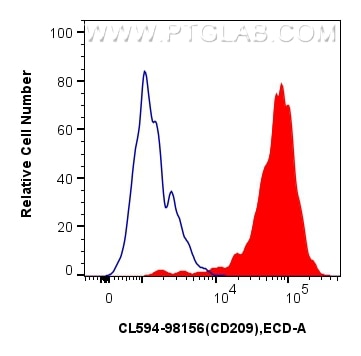Anticorps Recombinant de lapin anti-CD209
CD209 Recombinant Antibody for FC
Hôte / Isotype
Lapin / IgG
Réactivité testée
Humain
Applications
FC
Conjugaison
CoraLite®594 Fluorescent Dye
CloneNo.
240907A4
N° de cat : CL594-98156
Synonymes
Galerie de données de validation
Applications testées
| Résultats positifs en cytométrie | human monocyte-derived immature dendritic cells |
Dilution recommandée
| Application | Dilution |
|---|---|
| This reagent has been pre-titrated and tested for flow cytometric analysis. The suggested use of this reagent is 5 ul per 10^6 cells in a 100 µl suspension or 5 ul per 100 µl of whole blood. | |
| Sample-dependent, check data in validation data gallery | |
Informations sur le produit
CL594-98156 cible CD209 dans les applications de FC et montre une réactivité avec des échantillons Humain
| Réactivité | Humain |
| Hôte / Isotype | Lapin / IgG |
| Clonalité | Recombinant |
| Type | Anticorps |
| Immunogène | CD209 Protéine recombinante Eg0062 |
| Nom complet | CD209 molecule |
| Masse moléculaire calculée | 404 aa, 45.7 kDa |
| Numéro d’acquisition GenBank | BC110615 |
| Symbole du gène | CD209 |
| Identification du gène (NCBI) | 30835 |
| Conjugaison | CoraLite®594 Fluorescent Dye |
| Excitation/Emission maxima wavelengths | 588 nm / 604 nm |
| Forme | Liquide |
| Méthode de purification | Purification par protéine A |
| Tampon de stockage | PBS with 0.09% sodium azide and 0.5% BSA |
| Conditions de stockage | Store at 2-8°C. Avoid exposure to light. Stable for one year after shipment. |
Informations générales
CD209 (DC-SIGN, CLEC4L) is a C-type lectin receptor that is involved in the innate immune system and recognizes numerous evolutionarily divergent pathogens, including bacteria, viruses, and parasites. CD209 is preferentially expressed on dendritic cells (DCs). It mediates transient adhesion of DCs with T cells. It has been reported that CD209 plays a role in capture and transmission of HIV from DC to T cells (PMID: 10721995).
Protocole
| Product Specific Protocols | |
|---|---|
| FC protocol for CL594 CD209 antibody CL594-98156 | Download protocol |
| Standard Protocols | |
|---|---|
| Click here to view our Standard Protocols |


